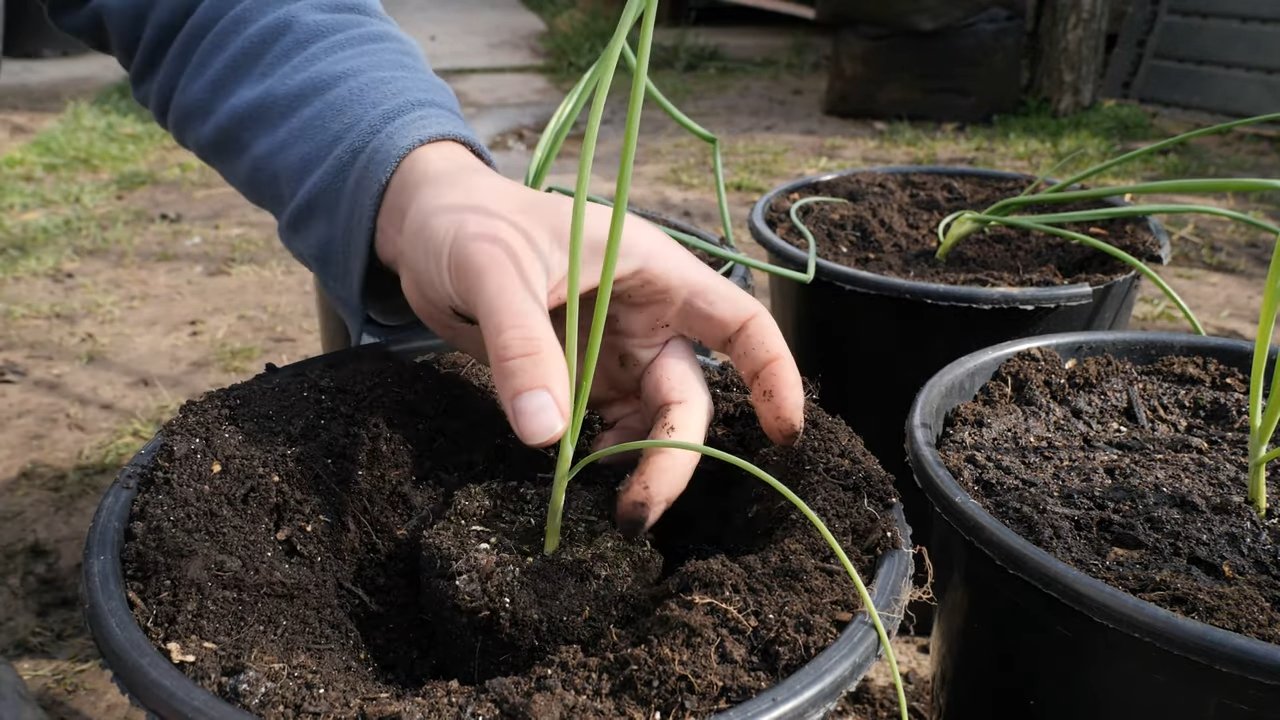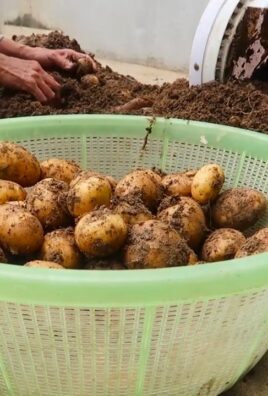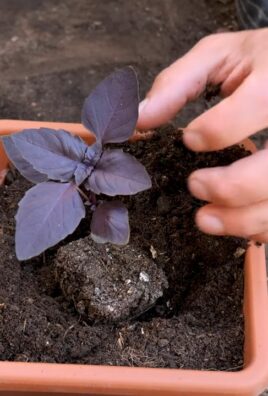Growing onions in small pots might seem like a challenge, especially if you’re dreaming of those jumbo-sized bulbs. But trust me, it’s totally achievable, even if you’re short on space! Have you ever imagined harvesting fresh, flavorful onions right from your balcony or windowsill? It’s not just a dream; it’s a delicious reality waiting to happen!
Onions have been cultivated for thousands of years, with evidence suggesting their use dates back to ancient Egypt. They were even revered as symbols of eternity! Today, while we might not be worshipping them, we certainly appreciate their culinary versatility. But let’s face it, not everyone has a sprawling garden to dedicate to these pungent delights.
That’s where this DIY guide comes in. Growing onions in small pots is the perfect solution for urban gardeners, apartment dwellers, or anyone who simply wants to enjoy the satisfaction of growing their own food without a lot of fuss. I’m going to share some simple yet effective tricks and hacks that will help you maximize your yield, even in the tiniest of containers. Imagine the joy of snipping fresh green onions for your salads or pulling up a perfectly formed bulb for your favorite recipes. Let’s get started and transform your small space into an onion-growing oasis!

Growing Onions in Small Pots: A Beginner’s Guide
Hey there, fellow gardening enthusiasts! Ever dreamt of having fresh onions readily available, even if you’re short on space? Well, you’re in luck! Growing onions in small pots is totally doable, and I’m here to guide you through the process. It’s surprisingly easy and rewarding. Let’s get started!
What You’ll Need
Before we dive into the nitty-gritty, let’s gather our supplies. Here’s a checklist of everything you’ll need to successfully grow onions in pots:
* Onion Sets or Seeds: You can use onion sets (small, immature onions) for a quicker start, or onion seeds if you’re feeling patient. I personally prefer sets for my container garden.
* Small Pots: Choose pots that are at least 6 inches in diameter and 6 inches deep. This gives the onions enough room to develop.
* Potting Mix: Use a high-quality potting mix that drains well. Avoid using garden soil, as it can compact in pots and hinder growth.
* Watering Can or Hose: For regular watering.
* Fertilizer (Optional): A balanced liquid fertilizer can give your onions a boost.
* Trowel or Small Shovel: For planting.
* Sunlight: Onions need at least 6 hours of sunlight per day.
* Gardening Gloves (Optional): To keep your hands clean.
Choosing Your Onions
The type of onion you choose will depend on your preferences and climate. Here are a few popular varieties that do well in containers:
* Shallots: These have a milder flavor and are great for salads and cooking.
* Green Onions (Scallions): These are quick to grow and perfect for garnishing.
* Red Onions: These add a beautiful color and a slightly pungent flavor to dishes.
* Yellow Onions: These are versatile and good for cooking.
* White Onions: These have a milder flavor than yellow onions.
Consider your local climate and the amount of sunlight your balcony or patio receives when making your choice.
Planting Your Onions
This is where the magic happens! Follow these steps to plant your onion sets or seeds:
1. Prepare the Pots: Fill each pot with potting mix, leaving about an inch of space at the top.
2. Plant Onion Sets: If you’re using onion sets, make a small hole in the soil about 1-2 inches deep. Place the onion set in the hole with the root end facing down and the pointy end facing up. Cover with soil, leaving the very tip of the onion set exposed.
3. Plant Onion Seeds: If you’re using onion seeds, sow them about 1/4 inch deep and 1/2 inch apart. Gently cover with soil. You may need to thin the seedlings later if they become too crowded.
4. Water Thoroughly: After planting, water the pots thoroughly until the water drains out of the bottom. This helps settle the soil and encourages root growth.
5. Place in Sunlight: Place the pots in a location that receives at least 6 hours of sunlight per day. A south-facing balcony or patio is ideal.
Caring for Your Onions
Now that your onions are planted, it’s time to provide them with the care they need to thrive.
1. Watering: Onions need consistent moisture, but they don’t like to be waterlogged. Water when the top inch of soil feels dry to the touch. Avoid overwatering, as this can lead to root rot.
2. Fertilizing (Optional): If you want to give your onions a boost, you can fertilize them every 2-3 weeks with a balanced liquid fertilizer. Follow the instructions on the fertilizer package.
3. Weeding: Keep the pots free of weeds, as they can compete with the onions for nutrients and water. Gently pull out any weeds that appear.
4. Pest Control: Onions are generally pest-resistant, but they can sometimes be affected by onion maggots or thrips. If you notice any signs of pests, you can use an insecticidal soap or neem oil to control them.
5. Sunlight Rotation: If you notice your onions leaning towards the sun, rotate the pots regularly to ensure even growth.
Harvesting Your Onions
The time it takes to harvest your onions will depend on the variety and whether you used sets or seeds.
* Green Onions (Scallions): These can be harvested as soon as they reach a usable size, usually within a few weeks. Simply snip off the green tops as needed.
* Bulb Onions: These are ready to harvest when the tops start to turn yellow and fall over. Gently pull the onions from the soil and let them dry in a warm, sunny place for a few days. This helps them develop a papery outer skin, which protects them during storage.
Troubleshooting
Even with the best care, you might encounter a few challenges along the way. Here are some common problems and how to address them:
* Yellowing Leaves: This can be caused by overwatering, underwatering, or nutrient deficiencies. Adjust your watering schedule and consider fertilizing your onions.
* Slow Growth: This can be due to insufficient sunlight or poor soil. Make sure your onions are getting enough sunlight and that the potting mix is well-draining.
* Pests: As mentioned earlier, onion maggots and thrips can sometimes be a problem. Use insecticidal soap or neem oil to control them.
* Root Rot: This is caused by overwatering. Make sure your pots have drainage holes and avoid watering too frequently.
Tips for Success
Here are a few extra tips to help you grow the best onions possible:
* Choose the Right Pot Size: Make sure your pots are large enough to accommodate the onions’ root systems.
* Use High-Quality Potting Mix: This will provide your onions with the nutrients they need to thrive.
* Provide Plenty of Sunlight: Onions need at least 6 hours of sunlight per day.
* Water Regularly: Keep the soil consistently moist, but avoid overwatering.
* Fertilize (Optional): A balanced liquid fertilizer can give your onions a boost.
* Harvest at the Right Time: This will ensure that your onions are at their peak flavor and quality.
* Succession Planting: Plant new sets every few weeks to have a continuous harvest.
* Companion Planting: Plant onions near carrots, chamomile, or marigolds to deter pests. Avoid planting them near beans or peas.
* Observe Your Plants: Pay attention to your onions and adjust your care as needed.
Storing Your Harvest
Once you’ve harvested your onions, you’ll want to store them properly to keep them fresh for as long as possible.
* Curing: After harvesting bulb onions, let them dry in a warm, sunny place for a few days until the outer skins are papery. This process, called curing, helps to prevent rot and extends their storage life.
* Storage: Store cured onions in a cool, dry, and well-ventilated place. A mesh bag or a basket is ideal. Avoid storing them in the refrigerator, as this can cause them to become soft and mushy.
* Green Onions: Green onions are best used fresh. You can store them in the refrigerator for a few days by wrapping them in a damp paper towel and placing them in a plastic bag.
Enjoying Your Homegrown Onions
Now for the best part – enjoying the fruits (or rather, vegetables!) of your labor. Your homegrown onions will add a delicious flavor to all sorts of dishes.
* Salads: Add sliced onions to salads for a crunchy and flavorful boost.
* Soups and Stews: Use onions as a base for soups and stews.
* Sautéed Dishes: Sauté onions with other vegetables for a quick and easy side dish.
* Grilled Dishes: Grill onions alongside meats and vegetables for a smoky flavor.
* Dips and Sauces: Use onions to add flavor to dips and sauces.
Growing onions in small pots is a rewarding experience that allows you to enjoy fresh, homegrown produce even if you have limited space. With a little care and attention, you can have a thriving onion garden on your balcony or patio. Happy gardening!

Conclusion
So, there you have it! Growing onions in small pots isn’t just a quirky gardening experiment; it’s a genuinely practical and rewarding way to enjoy fresh, flavorful onions, even if you’re short on space. We’ve walked through the process, from selecting the right onion sets or seeds to nurturing your tiny onion patch to a bountiful harvest.
Why is this DIY trick a must-try? Because it democratizes onion cultivation. No sprawling garden? No problem! A sunny windowsill, a balcony, or even a small patio can become your personal onion farm. It’s also incredibly satisfying to watch those little green shoots emerge and develop into plump, usable onions. Plus, you have complete control over the growing environment, minimizing the risk of pests and diseases that can plague larger gardens.
But the benefits extend beyond mere convenience. Growing your own onions allows you to experiment with varieties you might not find in your local grocery store. Imagine the culinary possibilities! From the subtle sweetness of Walla Walla Sweets to the pungent bite of red onions, you can tailor your onion crop to your specific tastes and needs.
Looking for variations? Absolutely! Consider these ideas to personalize your small-pot onion growing experience:
* Vertical Gardening: Maximize your space by using vertical planters or stacking pots. This is especially useful for balconies or small patios.
* Companion Planting: Plant herbs like chamomile or rosemary alongside your onions. These herbs can help deter pests and even improve the flavor of your onions. Marigolds are also excellent companions.
* Succession Planting: Plant new onion sets every few weeks to ensure a continuous harvest throughout the growing season.
* Different Onion Types: Experiment with different types of onions, such as scallions, shallots, or even garlic chives, in separate pots.
* Hydroponics: For the truly adventurous, try growing onions hydroponically in small containers. This method can lead to faster growth and higher yields.
Ultimately, the best way to discover the joys of growing onions in small pots is to simply dive in and try it yourself. Don’t be afraid to experiment, make mistakes, and learn from your experiences. Gardening is a journey, not a destination.
We’re confident that you’ll find this DIY trick to be a game-changer for your culinary adventures. The taste of freshly grown onions, harvested from your own little pot, is simply unmatched. It’s a flavor that will elevate your dishes and bring a smile to your face.
So, grab some pots, some soil, and some onion sets, and get ready to embark on a rewarding gardening experience. And most importantly, we want to hear about your journey! Share your successes, your challenges, and your tips with us in the comments below. Let’s create a community of small-pot onion growers and inspire others to discover the joys of homegrown goodness. We are eager to see how you make this DIY onion growing method your own!
Frequently Asked Questions (FAQ)
What kind of onions are best for growing in small pots?
The best onions for small pots are those that don’t require a lot of space to mature. Onion sets (small, immature onions) are generally preferred over seeds because they get a head start. Look for varieties like:
* Scallions (Green Onions): These are quick to mature and don’t need much space.
* Shallots: These are smaller than regular onions and produce multiple bulbs from a single set.
* Red Onions: Choose smaller varieties of red onions.
* White Onions: Similar to red onions, opt for smaller, quicker-maturing types.
* Multiplier Onions: These onions produce clusters of smaller onions, making them well-suited for container growing.
Avoid larger onion varieties like Walla Walla Sweets unless you have a particularly large pot.
How big should the pots be?
A good rule of thumb is to use pots that are at least 6 inches in diameter and 6 inches deep for individual onions. For multiple onions in a single pot, choose a larger container, such as a 12-inch pot, and space the onions about 3-4 inches apart. Remember that scallions can thrive in even smaller containers.
What kind of soil should I use?
Use a well-draining potting mix. Avoid using garden soil, as it can become compacted in pots and hinder drainage. A mix of potting soil, compost, and perlite or vermiculite is ideal. The compost provides nutrients, while the perlite or vermiculite improves drainage and aeration.
How much sunlight do onions need?
Onions need at least 6-8 hours of direct sunlight per day. Place your pots in a sunny location, such as a south-facing windowsill, balcony, or patio. If you don’t have enough natural light, you can supplement with grow lights.
How often should I water my onions?
Water your onions regularly, keeping the soil consistently moist but not waterlogged. Check the soil moisture by sticking your finger about an inch into the soil. If it feels dry, it’s time to water. Avoid overwatering, as this can lead to root rot.
How do I fertilize my onions?
Onions are heavy feeders, so regular fertilization is important. Use a balanced liquid fertilizer (e.g., 10-10-10) diluted to half strength every 2-3 weeks. You can also use a slow-release fertilizer at planting time.
How long does it take for onions to mature in pots?
The time it takes for onions to mature depends on the variety and growing conditions. Scallions can be harvested in as little as 30-45 days, while larger bulb onions may take 90-120 days.
How do I know when my onions are ready to harvest?
For bulb onions, the tops will start to turn yellow and fall over when they are ready to harvest. You can then gently pull the onions from the soil. For scallions, you can harvest them when they are about 6-8 inches tall.
What are some common pests and diseases that affect onions?
Common pests include onion maggots, thrips, and aphids. Diseases include onion rot and downy mildew. To prevent these problems, use well-draining soil, provide good air circulation, and inspect your plants regularly. If you notice any pests or diseases, treat them promptly with appropriate organic pesticides or fungicides.
Can I grow onions indoors year-round?
Yes, you can grow onions indoors year-round if you provide them with enough light and warmth. Use grow lights to supplement natural light, and keep the temperature between 60-75°F (15-24°C).
Can I transplant onions grown from seeds into pots?
Yes, you can start onion seeds indoors and transplant the seedlings into pots once they are a few inches tall. Be sure to harden off the seedlings before transplanting them outdoors.
What do I do if my onion plants are not growing well?
If your onion plants are not growing well, check the following:
* Sunlight: Are they getting enough sunlight?
* Water: Are you watering them properly?
* Fertilizer: Are you fertilizing them regularly?
* Soil: Is the soil well-draining?
* Pests and Diseases: Are there any signs of pests or diseases?
Adjust your growing conditions as needed to address any issues.
How do I store harvested onions?
Cure your harvested onions by laying them out in a warm, dry, well-ventilated place for 1-2 weeks. Once they are cured, store them in a cool, dry, dark place. Braiding the tops of the onions and hanging them is a traditional storage method.
Can I regrow onions from scraps?
Yes, you can regrow green onions from the white root end. Place the root end in a glass of water, and new green shoots will emerge. You can then plant the regrown onion in a pot.
Is growing onions in small pots worth the effort?
Absolutely! Growing onions in small pots is a rewarding and convenient way to enjoy fresh, flavorful onions, even if you have limited space. It’s a fun and educational activity that can bring joy to your gardening experience.





Leave a Comment